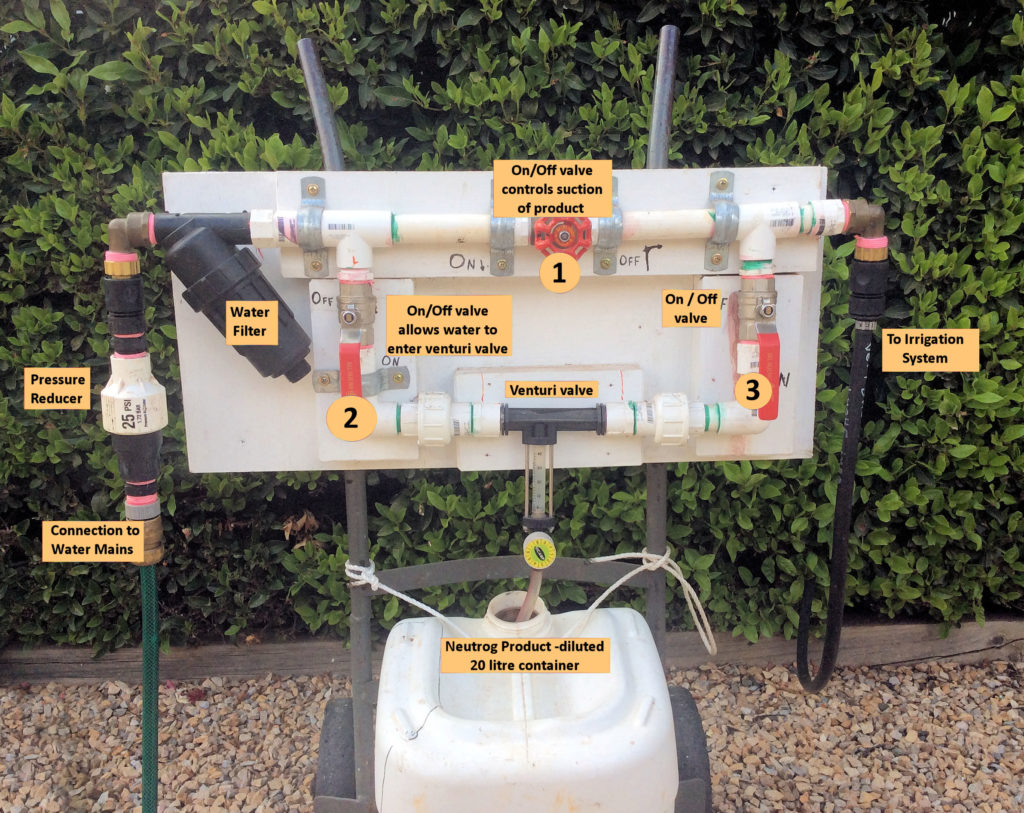Ross Kemp is a member of the Rose Society of South Australia and is from Riverton, a small town in the mid-north of SA. He designed his own fertigation system to stop pellet wastage, as he found that birds and other wildlife loved to eat them, so he’s kindly provided us with his research.
“Fertigation used in home gardens is probably the most efficient and effective way of applying fertiliser to your plants. A fertigation system delivers nutrients directly to the plant by using a hose attached to the 13mm inline dripper system, with water delivering a rate of 1.7 litres per hour.
The issue with fertigation is that most people need to get their head around how and why it works. Applying fertiliser by hand is possibly the easiest way that we fertilise our plants – unless you use a fertiliser cart, most people just grab
a handful and throw it around. By doing this though, you’re also fertilising the garden path, the lawn and the plants that don’t need that particular fertiliser.
What are the benefits of using a fertigation system?
- It is able to inject fertiliser (in this case Sudden Impact for Roses Liquid) as the nutrient and or other amendments through the irrigation water.
- Fertiliser applications followed the “watering” in process.
- Nutrient application is more accurate and uniform
- Nutrients are applied through the irrigation; nutrients land where the water lands
- Nutrients are immediately available to the plants
- Nutrients are best applied early in the morning or in the evening
- Nutrients must be in liquid form and can be Neutrog’s Seamungus, GOGO Juice, Sudden Impact for Roses or Strike Back for Orchids.
The fertiliser is applied through the irrigation system by adding an accessory called a fertigator that injects liquid fertiliser into the irrigation water prior to delivery to the sprinklers or drippers. It is connected to the irrigation main line to treat all the irrigation water applied to your plants. The injector or fertigator can be adjusted to inject at different rates of delivery of fertiliser, or at one set rate.
A fertigator is basically a venturi, which is a like two trumpet horns glued end to end, because it tapers in the middle to a smaller aperture. There is a change in pressure, meaning a suction effect is caused. By the time it comes out the other horn end, the pressure is back to normal again, and the water is enriched with nutrients.
My fertigator was mounted onto a backing board, so it’s easy to move around the garden with the use of a sack truck. It comprises of mostly plastic 25mm plumbing fittings available at most hardware or plumbing supply stores, which are glued to make a loop.

- An inlet that connects to a garden hose allows mains water into the system
- A pressure valve to reduce the water pressure to the level of the dripper system keeps the water pressure at a constant rate 25psi in this case. This stops blowing out connections and fittings in the dripper system, which is an added safety measure to protect the first couple of roses from getting dumped with all the nutrient.
- A ‘T’ connection goes to an on/off tap to the fertiliser indicated by the number (2) in the photo
- An on/off tap to control the volume of water to the irrigation system indicated by the number (1).
- Tap (2) connects to the venturi tube, the venturi tube is connected to an on/off tap (3)
- Tap (2) and (3) can be closed to isolate the system and stops back flow back into the twenty-litre drum
- The venturi valve allows product to be sucked into the system.
- The next T connections connects tap (3) to the irrigation system.
- A 20L drum contains product which has been diluted to 5ml per rose bush (100 roses equals 500ml of Neutrog’s Sudden Impact for Roses to 20 litres of water).
So how does the system work?
Mains water is connected via a hose to the fertigator system. Before entering the fertigator, the water pressure is reduced and kept to 25 PSI and filtered. Taps 2 and 3 are turned on, and Tap 1 controls the amount of suction into the system. Turning the volume of water down induces more suction of product from the drum. Tap 2 allows water into the venturi tube, which sucks liquid out of the 20L container of product via an 8mm tube. The water with the added product then goes past Tap 3 into the irrigation system.
To flush the irrigation system, open Tap 1 and close Taps 2 and 3. At this stage, mains water can either go straight through to the irrigation system to clean all the pipes of residual product.
People should be cautious about designing and implementing their own system, and products should be diluted in the 20L drum so not to overdose your roses, however, this is only part of a larger fertilising scheme for this garden – during winter (as there is rain about), pellets are distributed onto the garden, the rain dissolves the pellets, thereby saving water”.
